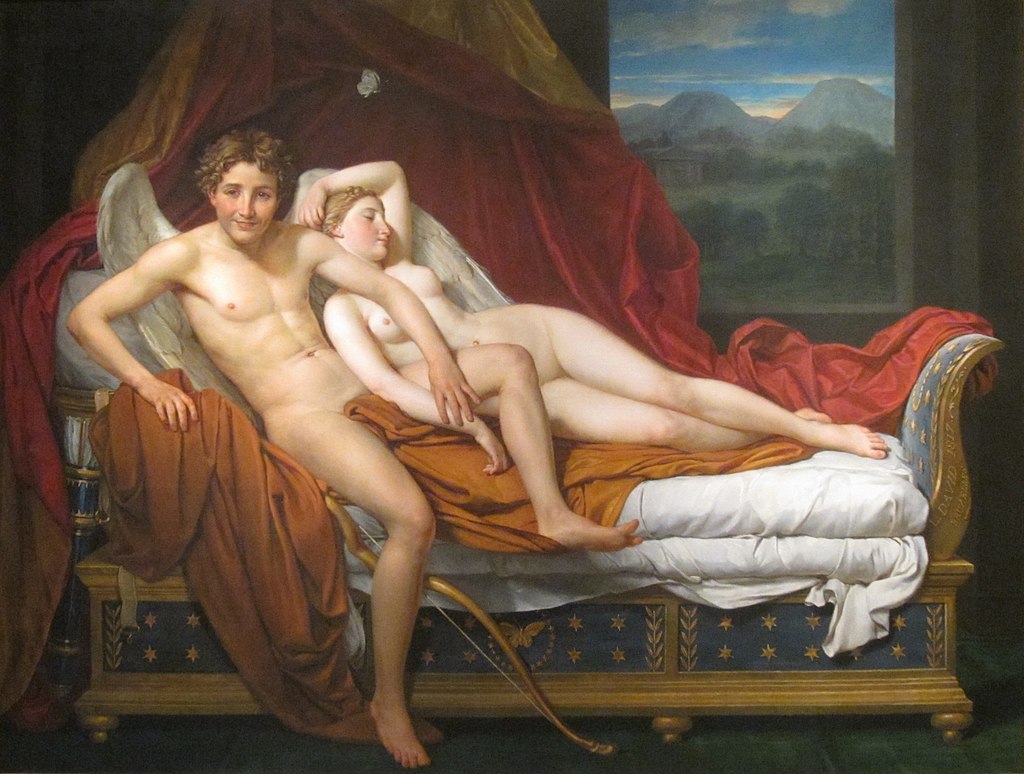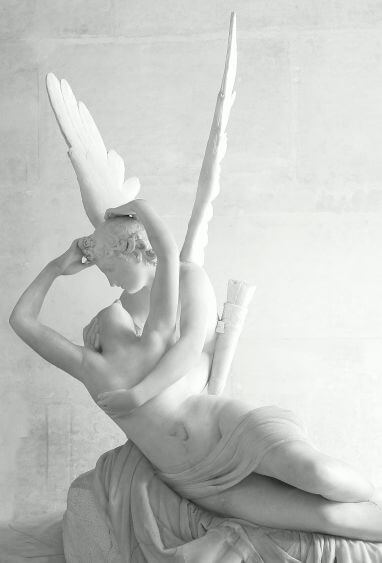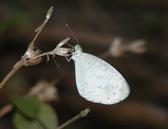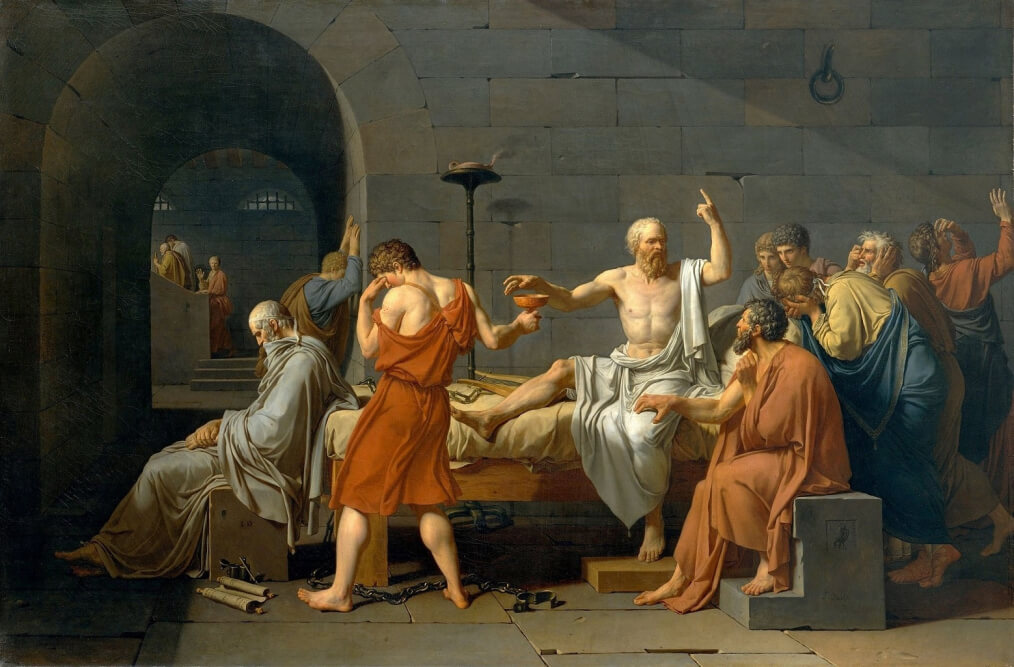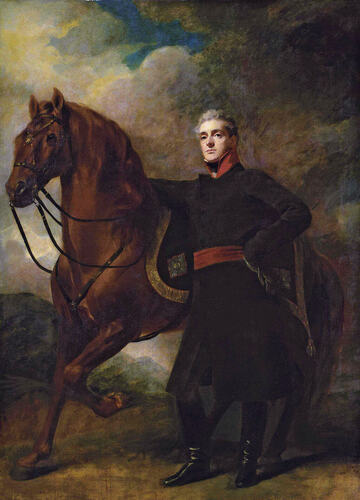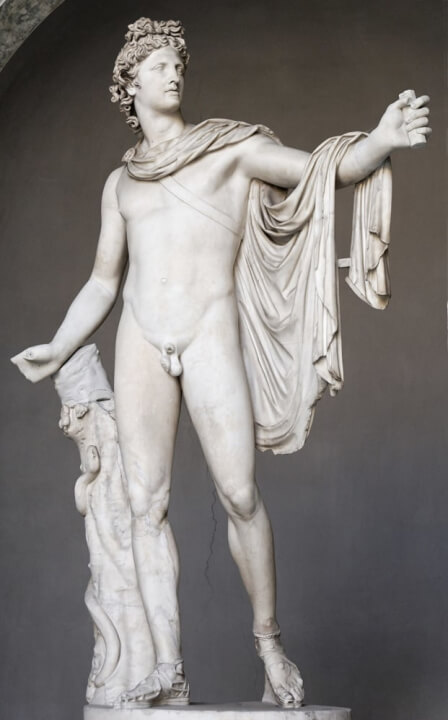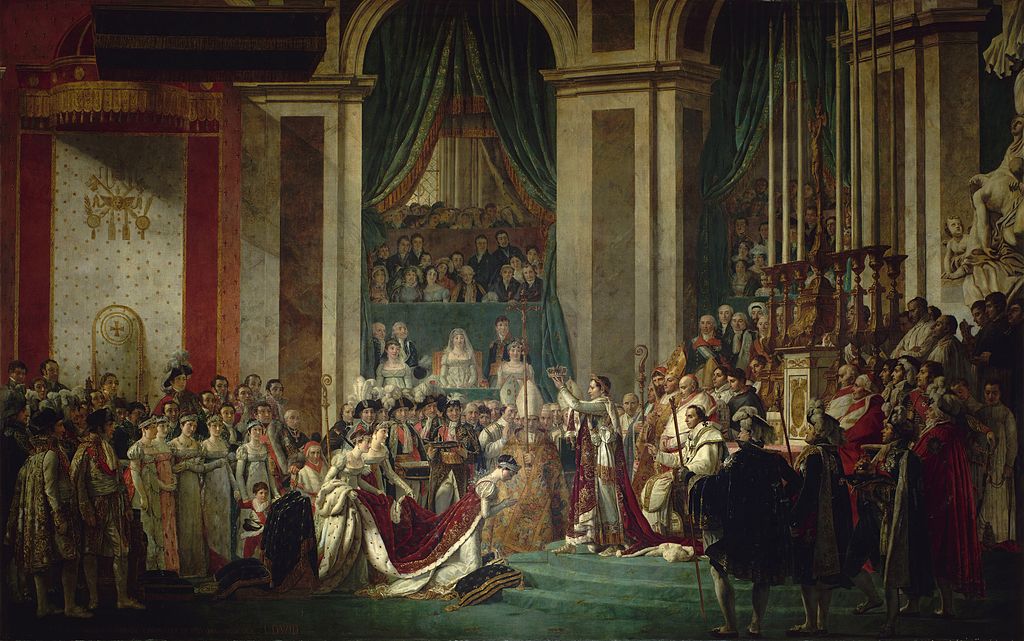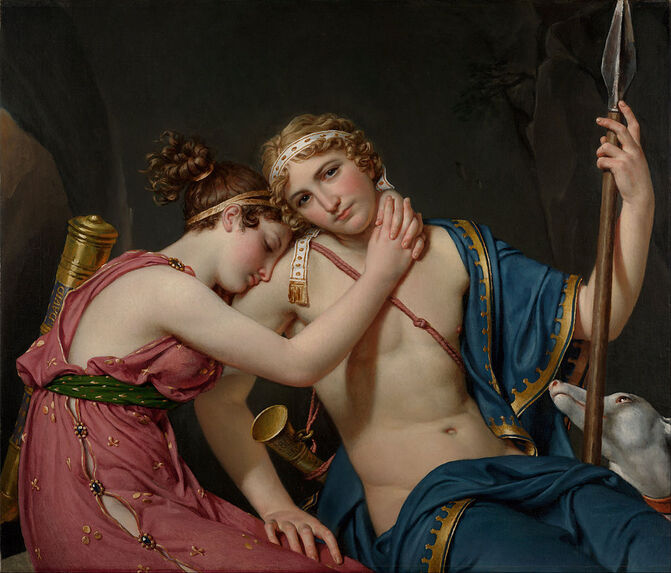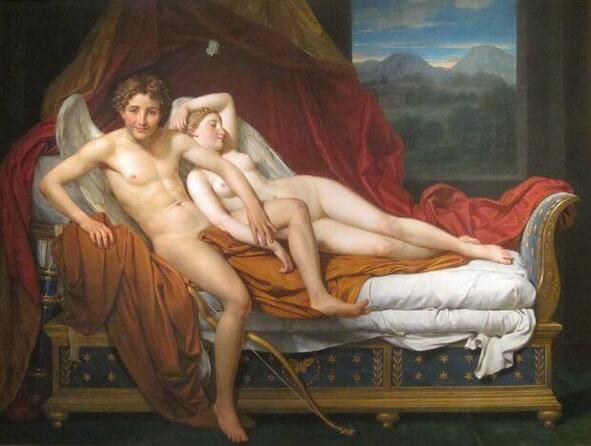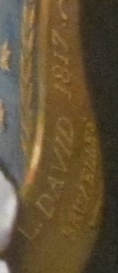 Inscription by David Inscription by David
Where? Gallery 201 of the Cleveland Museum of Art
When? 1817 Commissioned by? Giovanni Battista Sommariva, an Italian politician and art collector. What do you see? The beautiful nude Psyche sleeps on the bed after making love to Cupid. She has one arm over her head and the other arm lays over Cupid’s thigh. The couple lays on two large bedcovers that hang from the top of the painting. Cupid is awake and looks at the viewer with a smirky smile. He wears large white wings and has curly hair. However, something seems off about him. He looks like a teenager who is proud that he just made love to the most beautiful woman on Earth. He shows that pride with a somewhat annoying smile to the viewers. It seems that Cupid wants to sneak away as Psyche is not supposed to see who makes love to her every night. He tries to lift up the arm of Psyche such that he can leave (though he will still have to remove his wings from under Psyche’s body). The bow of Cupid stands against the bed below his right leg, and on the left side of the bed stands his quiver with arrows. Above the head of Psyche is a white butterfly, which is her symbol. Another butterfly is decorated on the middle of the bed frame in the middle of other gold decorations. In the background, we can look through a window at a landscape with mountains and a small temple. Jacques-Louis David has signed the painting on the footpiece on the right side of the bed. Backstory: This painting is also known under the name, Love and Psyche. Jacques-Louis David started this painting in 1813 when he still lived in Paris and finished it in 1817 when he lived in exile in Brussels. Before his exile, David was known for his paintings with political and social messages, but after his exile, he seemed to focus on less complicated subjects like the current painting. His sketchbooks from before his exile already contained many drawing of mythological subjects, so his exile was a good reason to convert some of those ideas into paintings. The story of Cupid and Psyche? This painting of Cupid and Psyche is based on a story that the Roman writer, Apuleius, wrote in his book Metamorphoses, chapters four, five, and six (you can download the book here for free). In short, Psyche was considered the most beautiful woman alive, and Cupid fell in love with her. The goddess Venus was jealous of her beauty. So, she sent Psyche on a very dangerous journey to the underworld to collect a flask with Proserpina’s beauty ointment. She succeeds with the help of Cupid. Venus instructed Psyche not to open the flask, but after she completes the journey, she could not resist and opened it to take some of the beauty. Instead of becoming more beautiful, the ointment makes her fall into a very deep sleep as Proserpina had filled the flask with sleep of the innermost darkness. Cupid forgives Psyche and revives her. Antonio Canova created a sculpture on the moment just after this revival. The sculpture, Psyche Revived by Cupid’s Kiss, is in the Louvre. After this, Cupid asks for the help of Zeus who makes Psyche immortal and Cupid and Psyche marry and stay together forever. The story of Psyche has inspired many artists over time, including Caravaggio, Raphael, Titian, and Vélazquez.
Symbolism: Most artworks on Cupid and Psyche focus on the love between both. They would show both of them with idealized bodies. However, that is not the case in this painting. At first glance, this painting seems to be about physical desire. Cupid is not depicted as a very handsome man, but as a teenager with a far from ideal face. He shares his pride about making love to such a beautiful woman by smirking at the viewer.
Looking a bit longer at the painting, it also presents a scene of the morning-after. They made love during the night, and in the morning, Cupid tries to sneak away from Psyche without saying goodbye. There has been quite some speculation about any deeper meanings behind this painting, especially because of the awkward depiction of Cupid, but no dominant one has emerged. Who is Jacques-Louis David? Jacques-Louis David was born in 1748 in Paris. He was one of the most popular painters during his life and one of the most famous Neoclassical painters. He was a supporter of the French Republic and Napoleon and even became the court painter of Napoleon. The Coronation of Napoleon in the Louvre is one of the magnificent paintings he created for Napoleon in 1807. After the fall of Napoleon in 1815, David was exiled from France. He wanted to spend the rest of his life in Rome, but the Pope did not approve this. Instead, he went to Brussels where he spent the rest of his life until his death in 1825. While in Brussels, he continued painting. One of the works he created there was The Farewell of Telemachus and Eucharis in the Getty Museum.
0 Comments
 The wife of Socrates The wife of Socrates
Where? Room 621 of the Metropolitan Museum of Art
When? 1787 Commissioned by? The Trudaine de Montigny brothers What do you see? Socrates is sitting on his deathbed in his cell and is reaching for the glass of hemlock to take his own life. He is convicted to death by a jury in Athens for not believing in the Greek gods and for sharing this view with the young people in Athens. You can see the opened shackles laying on the floor. His disciples are gathered around him and cannot believe what is going to happen. The executioner from the state is holding the glass for Socrates while looking away and covering his eyes. Even in the moment just before his death, the illuminated Socrates is teaching to the people around him with his hand up in the air. Plato is sitting at the end of the bed with his back towards Socrates and his eyes closed. He seems in his thoughts, but his ear is prominently depicted to indicate that he is listening to Socrates. Plato has documented several dialogues of Socrates as Socrates himself did not leave any written documents. You can see the scroll and the pot with ink at Plato’s feet to indicate that he will document the final speech of Socrates. Sitting to the right of Socrates is Crito, a good friend of Socrates, who has his arm on his leg. Crito is sitting on a bench with an inscription of the symbol of the Athenian state. The wife of Socrates, Xanthippe, is in the left background in a red robe. She waves at us while walking away. Backstory: This painting is largely based on a dialogue of Plato, entitled Phaedo, in which he describes the death of Socrates. In this dialogue, Socrates discusses the life after death on the day before his execution. Socrates discusses various arguments on why the soul is immortal and that there is an afterlife for the soul. For his crimes, Socrates could choose between drinking the glass of the poisonous hemlock or being exiled. Given his ideas that his soul would go to an afterlife and staying true to his beliefs, he chose to drink the glass of hemlock. This painting can be interpreted in a political context. The Trudaine de Montigny brothers (who commissioned this work) were leaders of a movement that called for more open public discussion of political matters and a free market system. The motive behind this painting was to depict Socrates as an example of someone who was willing to die for his ideals. In 1787 reforms to the French political system were abandoned and there were many political prisoners. What is discussed in Phaedo? Phaedo is the fourth and final dialogue of Plato about the death of Socrates. In Phaedo, the story of Socrates is told about why he thinks that the soul is immortal and that there is life for the soul after a person dies. Phaedo also describes the death of Socrates. In short, the four arguments of Socrates are:
Who is Socrates? Socrates is one of the founders of Western philosophy. He was married to Xanthippe and got three sons. Socrates did not write any of his ideas on paper, but some contemporaries, such as Plato, have documented the ideas of Socrates such that his ideas have been saved for future generations. One of his most important contributions to the world is the so-called Socratic method. To solve a problem, Socrates would ask you a question. Based on your answer he would ask you another question, followed by another question, etc. He forced people to critically think about their answers by engaging them in the topic. If some of those answers led to contradicting answers, a certain hypothesis about the problem could be eliminated, and a better one could be formulated. It is basically a test of logic and will help a group of people to determine their views on a certain problem. The Socratic method has led to the currently-used scientific method that academicians use in which one starts with a hypothesis which can be rejected or accepted after research. Who is Jacques-Louis David? Jacques-Louis David (1748-1825) was born in Paris. He was a Neoclassical painter and together with Antonio Canova he is one of the main representatives of this art style. In his twenties and thirties, he spent quite some years in Rome where he got inspired by the Renaissance paintings and especially by the work of Raphael. David supported the French Revolution and Napoleon, and one of his famous paintings is The Coronation of Napoleon which is in the Louvre. After the fall of Napoleon, he moved to Brussels where he stayed until his death. He loved to make historical paintings while staying true to his Neoclassical style. In this painting, you can, for example, see how the body of Socrates resembles an ancient Greek sculpture. One of his most famous students is Eugene Delacroix.
Fun fact: There are several aspects of this painting that Jacques-Louis David changed compared to the historical accounts of the death of Socrates.
Where? Gallery 56 of the National Gallery of Art
When? 1812 Commissioned by? Alexander Douglas, the Duke of Hamilton, Scotland What do you see? Napoleon poses in his study in the Tuileries Palace. He has worked all night on the Code Napoléon, which is the civil code full of laws for his empire. His work is illustrated by the quill pen on the left of the desk, the papers laying on the right side of the desk, and the scroll with the letters ‘COD,’ which is the Code Napoléon. He gets up from his work to carry his sword and inspect his troops. Napoleon wears the uniform of the foot grenadiers of the Imperial Guard, a group of elite soldiers in the French army. His uniform consists of the colors of the French flag: blue, white, and red. His uniform is decorated with several military awards (including the legion of honour on the left, the highest French military award), gold buttons, and gold epaulets. He has his right hand in his vest, which is a typical pose for Napoleon, and in his left hand, he holds a so-called snuffbox filled with tobacco. Jacques-Louis David included quite some details in this painting that help to tell a story about Napoleon.
Backstory: In 1811, Alexander Hamilton (1767-1852), the Marquis of Hamilton, contacted Jacques-Louis David to paint a portrait of Napoleon. The Duke admired Napoleon for his power and asked David to “transfer onto the canvas the features of the Great Man, and represent him in one of the historic moments that have made him immortal.” For the rest, David was free to decide on the content of the painting, and he could even decide himself on the price that the Duke would have to pay for it. David happily accepted the commission as it was a recognition of his fame outside France, he did not have any major commissions from the French government, and he could earn a lot of money with it. The painting is since 1961 in the National Gallery of Art.
Symbolism: Jacques-Louis David wanted to portray Napoleon as a correct and truthful man. He also wanted to indicate that Napoleon worked very hard for his empire. He purposely included a clock with the time of 4.13am and a candle that was almost finished to indicate that Napoleon was still working deep into the night.
To further emphasize the hard work of Napoleon, David paints him with unkempt hair, wrinkled stockings wrinkled, and the cuffs of his uniform are not all buttoned. Also, the snuffbox in his right hand shows that he used the tobacco to stay awake. The military decorations and the sword on the chair indicate his success as a military leader. The golden bees on the chair on the left symbolize the diligence of Napoleon. Who is Napoleon? Napoléon Bonaparte (1769-1825) was a military political leader in France. He was the leader of the French Revolution in 1789 and became the Emperor of France in 1804. For the next decade, he was the most important statesman in Europe as the French Empire spanned across a large part of Europe, including countries like Italy, Belgium, and The Netherlands. Who is David? Jacques-Louis David (1748-1825) was born in Paris and died in Brussels, Belgium. He is considered the most important Neoclassical painter. David was an admirer of Napoleon and Napoleon was also a big fan of the work of David. In 1804, David became the official court painter of the French empire. He painted multiple works of Napoleon, including the famous The Coronation of Napoleon in the Louvre. Due to his focus on neoclassicism, he also painted a large number of paintings with classical themes, such as The Death of Socrates (1787) in the Metropolitan Museum of Art and The Farewell of Telemachus and Eucharis (1818) in the Getty Museum.
What is the Tuileries Palace? A palace in Paris that was used by many French monarchs until it burned down in 1871. It was built in 1564 and was an enormous palace in the middle of Paris, next to the Louvre.
Fun fact: Napoleon liked art. For example, the Mona Lisa by Leonardo da Vinci hung in his bedroom. He ordered his troops to bring a lot of famous artworks from throughout Europe to France, including the Apollo Belvedere and The Entombment of Christ by Caravaggio in the Vatican Museums, and The Wedding at Cana by Paolo Veronese in the Louvre. He was also a commissioner and collector of contemporary art, though often to promote himself or his empire. Some of the paintings by David, such as the Coronation of Napoleon, are a good example of this self-promotion. Interested in a copy for yourself? Poster.  Jacques-Louis David in the background Jacques-Louis David in the background
Where? The original is on the first floor, Room 702 of the Denon wing in the Louvre. A copy by David is in The Coronation Room of the Palace of Versailles.
When? 1805-1807 Commissioned by? Napoleon Bonaparte Also known as? This painting is officially entitled The Coronation of the Emperor Napoleon I and the Crowning of the Empress Joséphine in Notre-Dame Cathedral on December 2, 1804. What do you see? A large number of almost life-size figures are present in the Notre-Dame Cathedral for the coronation of Napoleon Bonaparte. This painting (979cm x 621cm) is one of the largest works in the Louvre. Napoleon is the person in the middle holding the crown, and the painting shows the moment that Napoleon is about to place the crown on the head of his wife Joséphine who is kneeling on a pillow. Napoleon wears his coronation robe, which is similar to the robes worn by Roman emperors. The person sitting to the right of Napoleon is Pope Pius VII. He blesses the coronation but is participating involuntarily under the pressure of Napoleon. The woman in the white dress sitting on a chair in the center of the painting is the mother of Napoleon. In the left foreground, you can see the two identically dressed (wearing black hats) brothers of Napoleon, Joseph (on the left) and Louis (on the right). To the right of Napoleon’s brothers are his three sisters (also identically dressed). From left to right, they are Caroline, Pauline, and Elisa. To the right of Napoleon's sisters, and again similarly dressed, are Hortense (the daughter of Joséphine) and Julie Clary (the wife of Joseph Bonaparte). In the background, Jacques-Louis David also painted himself as he was present at this event. Finally, look at the expressions of all the 204 faces in the painting. They all look quite serious, signifying the importance of this event. Backstory: This painting captures an important event in history, and Jacques-Louis David was in the audience that day. On December 2, 1804, the 35-year-old Napoleon Bonaparte crowned himself during a five-hour ceremony as the first Emperor of France. And he crowned his 41-year-old wife Joséphine as the first Empress. Before the French Revolution of 1789, France was a monarchy, but the revolution turned France into a republic. This painting shows the moment that Napoleon turned France back into a monarchy. He brought in Pope Pius VII from Rome to bless him at the event. The painting is a fairly accurate representation of history, but not everything in the painting is true. Several details are changed to favor Napoleon. For example, the mother of Napoleon, Letizia Bonaparte, was in Rome during the coronation, but she still received a prominent place in this painting. Napoleon's brother Joseph on the left was also not present at the event. When David finished the painting and Napoleon saw it for the first time, he said: “It is not a painting. There are people walking in this picture. Life is everywhere. David, I salute you. You have made me a French knight.” Two versions: Jacques Louis David finished the original version of this painting in 1807. It was originally on display in the Palace of Versailles but was moved to the Louvre in 1889. Between 1808 and 1822, David painted a second version of this painting for some American businessmen. The Palace of Versailles acquired it in 1947. David painted this copy based on the preparatory drawing he had for the original, and the two versions differ slightly from each other, though the differences are minor.
Who is Napoleon? Napoleon Bonaparte (1769-1821) was one of the leaders of the French Revolution in 1789. He was a successful military leader, and he became a general in the French army at age 24. He was the leader of a coup in 1799 and eventually crowned himself as the emperor of France in 1804.
Napoleon was married to Joséphine who is crowned in this painting. He divorced her in 1809 because she could not get children (even though she got two children from her previous husband). He later married Marie Louise, the daughter of the Emperor of Habsburg. He died in 1821 while in exile on the remote island Saint Helena in the middle of the Atlantic Ocean. Who is Jacques-Louis David? Jacques-Louis David (1748-1825) was considered the best painter of his era. From a young age, he received a great education in arts. In 1774 he won the Prix de Rome, a prestigious art scholarship that allowed him to work for five years at the French Academy in Rome. David abandoned the dominant Rococo style and developed a Neoclassical approach. He was specifically inspired by the works of Raphael and painted many historical scenes inspired by ancient Greece and Rome. For example, in 1787 he painted The Death of Socrates, which is in the Metropolitan Museum of Art in New York. During the time of the French revolution, David was involved in politics and devoted himself to Napoleon who knighted him in 1803. In 1812, he painted The Emperor Napoleon in His Study at the Tuileries in the National Gallery of Art. David has taught many other well-known artists, such as Jean-Auguste-Dominique Ingres and Antoine-Jean Gros.
Fun fact: Napoleon thought it to be a good idea to have the Pope bless him in order to turn France into a Christian monarchy. However, it was common that someone who wanted to be blessed by the Pope traveled to Rome. Napoleon wanted instead for the Pope to come to France to establish his dominance in power over the Pope. The Pope, though, initially did not want to travel to Paris without a good religious reason.
In the end, the Pope reluctantly agreed, having the idea that by coming to Paris he could get some favorable concessions from Napoleon to the Catholic Church. This, however, turned out to be a false idea and the Pope had to bless Napoleon against his will. Finally, at the moment the Pope wanted to crown Napoleon, he took the crown from the Pope and put it on his own head. This act was seen as a public humiliation of the Pope. Interested in a copy for yourself? Poster or canvas.
Where? Room S204 of the J. Paul Getty Museum
When? 1818 Commissioned by? Unknown. However, just before David finished the painting, it was bought by Franz Erwein, Count of Schonborn-Wiesentheid, a politician and art collector from Germany. What do you see? The beautiful nymph Eucharis is on the left. On the right is the muscular Telemachus, the son of Odysseus and Penelope. Telemachus and Eucharis are in love with each other and say their final farewell in a dark cave before Telemachus will leave to continue the search for his father. Eucharis has her head on his shoulder and her eyes closed while embracing Telemachus. She wears a red dress (called a chiton), which is held together on the side and the top by jeweled clasps. She also wears a green sash which accentuates the shape of her breasts. On her back is a golden quiver, inscribed with the last name of Jacques-Louis David. Telemachus has golden, curly hair with a decorated hairband is bear-chested, and wears a blue garment with golden edges. He has his right hand on her thigh, and he holds his spear with his left hand. Telemachus already seems to be thinking about the future and looks at the viewers of this painting. On his back, he wears his golden horn, which is inscribed with the year and the place at which the painting is created (1818, Brux.). On the right is the white hunting dog of Telemachus. He looks at Telemachus to support him at this moment. Backstory: According to Jacques-Louis David, he created this work to complement his painting Cupid and Psyche from 1817 in the Cleveland Museum of Art. He created Cupid and Psyche for an Italian art collector, count Sommariva, but there is no evidence that the painting on Eucharis and Telemachus was also intended for him. In 1818, Franz Erwein visited the studio of David just before he finished the painting of Eucharis and Telemachus and bought it. The Getty Museum acquired this painting on an auction in 1987 for a little bit over $4 million. The last time the painting was sold before that, in 1950, was for only $3,950 to a private dealer.
The story of Eucharis and Telemachus? Telemachus is the son of the Greek hero Odysseus and his wife, Penelope. He is well-known because, in the first four books of the Odyssey (Amazon link to this book) by Homer, he searches for his father. Odysseus had left for Troy when Telemachus was still a baby and was already gone from home for 20 years.
The story in this painting by Jacques-Louis David is inspired by the popular French book Les Aventures de Télémaque, fils d’Ulysse, translated as The Adventures of Telemachus, Son of Odysseus (Amazon link to this book). François Fénelon wrote this book in 1699, and it fills in some of the gaps in Homer’s Odyssey, specifically the extensive travels of Telemachus to find his father. While they are on the isle of the goddess Calypso, Cupid makes Eucharis and Telemachus fall madly in love. However, at some point, Telemachus needs to leave to continue the search for his father, Odysseus, and they arrange a final moment to say goodbye to each other. Interestingly, though, this specific moment of goodbye is not described in the book by Fénelon. Who is David? Jacques-Louis David was born in Paris in 1748 and died in Brussels in 1826. He is a Neoclassical painter and had a large number of students, including Jean Auguste Dominique Ingres. He mainly painted portraits, historical scenes, and mythological scenes. An example of the latter is The Death of Socrates in the Metropolitan Museum of Art. David was a supporter of the French Revolution, and in 1804 he was appointed the court painter of Napoleon. There, he painted the famous The Coronation of Napoleon which is in the Louvre. When Napoleon was defeated in 1815, David moved to Brussels even though the new King, Louis XVIII, offered him a position as court painter. In Brussels, he continued to paint until his death.
Fun fact: David was politically engaged in his life and his paintings often contained moral and social messages. However, after he moved to Brussels, he lost his political influence in France and his painting style changed. He wanted to focus more on the composition of his paintings and enjoy the last years of his life peacefully, without painting deeper political messages.
The Farewell of Telemachus and Eucharis painting seems to have two relatively straightforward symbolic messages.
|
Categories
All
|
- Home
- Blog
-
Museums
- Alte Pinakothek
- Art Institute of Chicago
- Baltimore Museum of Art
- Barber Institute of Fine Arts
- Bargello
- Barnes Foundation
- British Museum
- Church of Sant’Anastasia
- Cleveland Museum of Art
- Courtauld Institute of Art
- Detroit Institute of Arts
- Frans Hals Museum
- Galleria Borghese
- Gallerie dell'Accademia
- Getty Museum
- Guggenheim
- Hermitage Museum
- Kunsthistorisches Museum
- Kunstmuseum Basel
- Legion of Honor Museum
- Louvre
- Mauritshuis
- Metropolitan Museum of Art
- Musee d’Orsay
- Museum of Fine Arts in Boston
- Museum of Modern Art
- National Gallery in London
- National Gallery of Art
- National Museum in Poznań
- Norton Simon Museum
- Ny Carlsberg Glyptotek
- Palace of Versailles
- Palazzo Pitti
- Palazzo Vecchio
- Petit Palais
- Philadelphia Museum of Art
- Prado
- Pushkin Museum
- Ravenna Art Museum
- Rijksmuseum
- San Diego Museum of Art
- Santa Maria delle Grazie
- St. Peter's Basilica
- Städel Museum
- Statens Museum for Kunst
- Tate Britain
- Tate Modern
- Timken Museum of Art
- Uffizi
- Vatican Museums
- Wallace Collection
-
Artists
- Altdorfer
- Anguissola
- Berlin Painter
- Bosch
- Botticelli
- Boucher
- Bronzino
- Bruegel the Elder
- Brunelleschi
- Cabanel
- Caillebotte
- Canova
- Caravaggio
- Carpeaux
- Cezanne
- Cimabue
- David
- Degas
- Delacroix
- De Maria
- Donatello
- El Greco
- Fontana
- Fra Angelico
- Fragonard
- Gauguin
- Gentileschi
- Gericault
- Gonzalez-Torres
- Goya
- Hals
- Hogarth
- Hokusai
- Ingres
- Leonardo da Vinci
- Lippi, Filippo
- Longhi, Barbara
- Lorrain
- Makovsky
- Manet
- Massys
- Matisse
- Merian
- Michelangelo
- Mochi
- Modigliani
- Monet
- Panini
- Parmigianino
- Perugino
- Picasso
- Pisanello
- Raphael
- Rembrandt
- Renoir
- Reynolds
- Rivera
- Rodin
- Rubens
- Scultori
- Seurat
- Steen
- Tintoretto
- Titian
- Toulouse-Lautrec
- Turner
- Uccello
- Van der Weyden
- Van Dyck
- Van Eyck
- Van Gogh
- Van Hemessen
- Vasari
- Velazquez
- Vermeer
- Veronese
- Vigée Le Brun
-
Locations
- Books
- About Us

